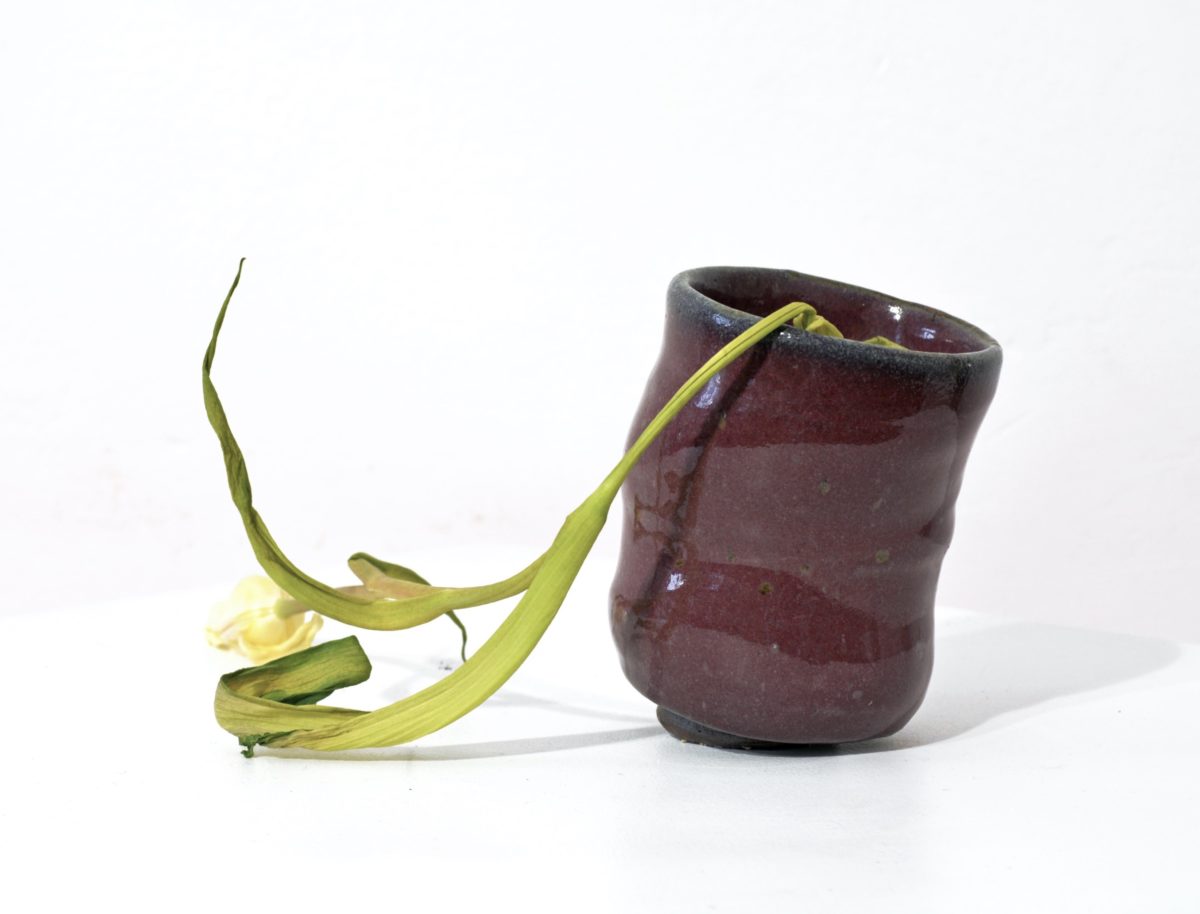様式の死 | 東野雄樹
様式とは何か?それは簡単な質問で簡単な答えである。経済、政治、芸術とデザインの歴史、社会の動向、実際の気候、趣味、技術などを含む複数の要素が特有のコンフルエンスの結果であるため、どの様式について話すことは最初から難しい。例えば19世紀のフランスのジャポニズムや16世紀の日本の南蛮芸術の場合に同様に見られるように、国家のロマン主義は、外国文化を賞賛するか、或いは外部からの影響を拒絶する(常に失敗)。言い換えれば、様式とは、審美的な解決策として一時的に中断された不安定なハイブリッド性であり、自然界では一時的なものであり、形成されるとすぐに無数のバリエーションに分解されるものなのだ。
当初、私は、急速な技術進歩と建築/デザインの関係における明らかな歴史的パターンに興味を持っていた。生産技術に大きな進歩があるとき、デザイナーの最初の本能とは、明らかに卓越した製品で消費者を幻惑させることを主な目的とした、複雑で豊かな空間を生み出すことであると私は見ている。産業革命での最初の本質的な様式であるアールヌーボーの場合がそうであり、それは現代パラメトリシズム(老朽化の流れの上で)とデジタル革命との関係にも垣間見られる。複雑な形での彼らの素朴な喜びと、世界をトータルデザインに変えるレトリックは、新技術によって引き起こされた熱の症状のように見受けられる。
しかし、私の関心は、様式そのものの概念、そしてより正確には様式の老朽化、死、崩壊と他の何かに変化する概念へと急速に拡大した。ザハ・ハディッドの死、そして誇大妄想的で、やや悲劇的なパトリック・シューマッハのパントマイムのパフォーマンスが、私の感情の変化に貢献したのだと信じる。
であるから、私は今回の作品シリーズを、様式がどのように消耗されるのか、消耗される様式から抜け出すことができるのかどうかを反映させる形で開発している。
私は、私の父親で陶芸家のアビィ・ベラハにアールヌーボーの花瓶の解釈に基づく一連の彫刻の制作を依頼した。一方で、私の新作の絵画は、パラメトリシズムの言語にレスポンドする。
制作中の意見交換の結果としての作品アンサンブルは、スタイルそのものの概念と類似の関係を持っている。私は、戦後の西洋のネオ・アバンギャルドの伝統的な修練を受けた、ヨーロッパに住む日本人アーティストである。私の父親は、兵庫に拠点を置くユダヤ人の陶芸家で、伝統的な日本の備前焼の修練を受けた。本展覧会の準備のために我々が共同で制作した文化ダイナミクスは、複雑な歴史や審美的な質問に反映されているが、そこには混乱があり、その混乱は様式の厄介な問題に適合していいると言えるだろう。
The Dying Style – Yuki Higashino
What is style? It is a simple question with no easy answer. It is already difficult to talk about a style because any style is a result of idiosyncratic confluence of multiple factors that include economy, politics, art and design history, social climate, actual climate, taste, technology, etc. A style could overtly celebrate a foreign culture, as was the case of for instance the 19th century French Japonism or the 16th century Japanese Nanban art, or rejects (always unsuccessfully) outside influences, which National Romanticism for example tried to do. In other words, style is unstable hybridity temporary suspended through aesthetic resolution, and by nature ephemeral, always dissolving into countless variations as soon as it was formed.
Initially, I was intrigued by the apparent historical pattern in the relationship between rapid technological advance and architecture/design. I noticed that when there is a major reap in production technology, the first instinct of designers is to go curvy, to produce complex and opulent space whose main aim is to dazzle users with its obvious fabrication virtuosity. That was the case with Art Nouveau, the first genuine style of the industrial revolution, and that is the case with contemporary (though aging) Parametricism and its relationship with the digital revolution. It seemed to me that both their naïve delight in complex forms and their rhetoric of transforming the world into a total design are the symptoms of the fever induced by new technology.
However, my interest quickly expanded to the notion of style itself, and more precisely how style age, die, decay and become something else. I believe that death of Zaha Hadid, and the megalomaniac and slightly tragicomic pantomime Patrik Schumacher continues to perform, contributed to the change in my sentiment.
So I am developing this series as a reflection on how a style exhausts itself, and whether it is possible to make work out of an exhausted style.
I commissioned ceramicist, and my father, Avi Beracha to produce a series of sculptures based on his interpretation of Art Nouveau vases. Meanwhile, my new paintings respond to the language of Parametricism.
The exchange during the production and the resulting ensemble of works have an analogous relationship with the notion of style itself. I am a Japanese artist living in Europe, and I was trained in the tradition of post-war western neo avant-garde. My father is a Hyogo-based Jewish ceramicist trained in traditional Japanese pottery in Bizen. The cultural dynamic created by us working together to prepare this exhibition, which reflects on a complex historical and aesthetic question, is messy, and this messiness is appropriate to the messy question of style.
東野雄樹は、オーストリアのウィーンを拠点に活動。2010年、フランクフルトのStädelschule修了。近年の個展と二人展に、ウィーンのアンナでの 「Furnished(2017年)」、チューリッヒのKIOSK TABAKでの「The Portraitist(2017年)」、ブルノHouse of Arts内の G99ギャラリーでの「東野雄樹/ ElisabethKihlström(2016年)」、ウィーンのSchneidereiでの「特別な理由なしに特定の時間に特定の場所に収束した無意味な恐怖(2016年)」、ウィーンのピナコテカでの「赤い目の雄牛(2014年)」、同じく2014年にエリザベス・キールストロムと共に、マルモのSkåneskonstföreningでの「Territories」、 とストックホルムのアナログでの「Port」。グループ展にLe BBBアートセンター(トゥールーズ)、Living Art Museum(レイキャヴィーク)、Fotografisk Centre(コペンハーゲン)など。ArtForum、Texte zur Kunst、Camera Austria、springerinなどの媒体に寄稿。
Yuki Higashino is based in Vienna. He graduated from Städelschule, Frankfurt, in 2010. His recent solo and two-person shows includes “Furnished” at Anna, Vienna, “The Portraitist” at KIOSK TABAK, Zurich (both 2017), “Yuki Higashino/Elisabeth Kihlström” at Gallery G99, The House of Arts, Brno, “Purposeless terror that converged upon a particular place at a particular time for no particular reason” at Schneiderei, Vienna (both 2016), “A bullfrog with red eyes” at Pinacoteca, Vienna (2014), “Territories” at Skånes konstförening, Malmö and “Port” at Mount Analogue, Stockholm (both with Elisabeth Kihlström, 2014). He has participated in group exhibitions at Le BBB centre d’ art, Toulouse, The Living Art Museum, Reykjavík and Fotografisk Center, Copenhagen among other venues. His writing has been published in journals such as ArtForum, Texte zur Kunst, Camera Austria and springerin.
